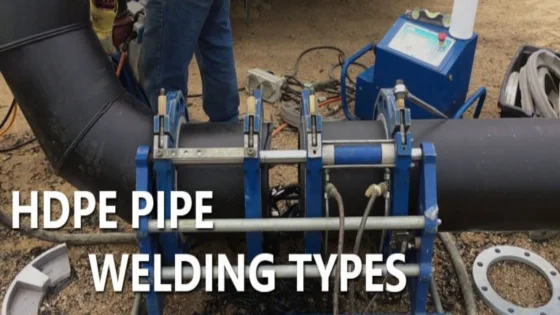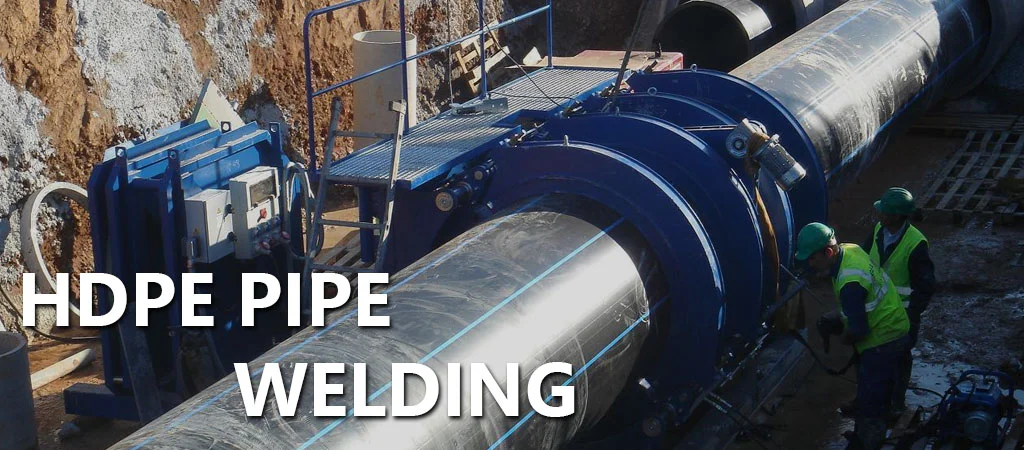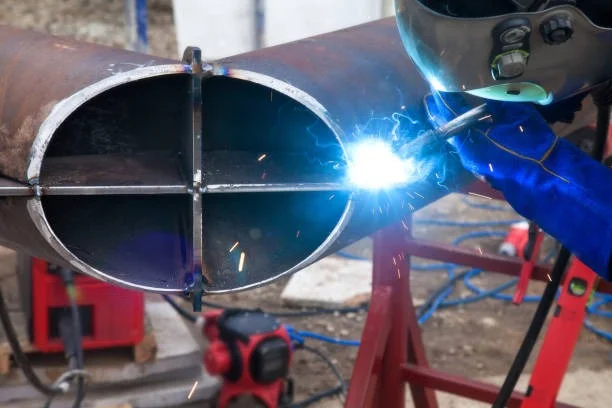HDPE Pipe Welding Types

What is an HDPE Pipe?
HDPE Pipe is a type of flexible plastic pipe used for water supply and gas transfer and is often used to replace aging concrete or steel main pipelines. High-density polyethylene pipes for water and gas are made from thermoplastic these pipes have a high level of permeability and strong molecular bonds which make them suitable for high-pressure pipelines.
What is HDPE Welding?
HDPE welding is a process used to weld HDPE pipes together. There are different types of fusion including saddle fusion or socket fusion, but in this talk, we will discuss butt fusion.
For butt fusion, two separate pieces of pipe are loaded into the machine and a cutting face rotates and cuts both pipes’ ends to create a smooth edge for proper bonding. The pipes are then put into contact with a heat plate, usually heated up to at least 400 degrees Fahrenheit, but some machines can go up to 800 degrees. The welding takes place when the two pipes are pressed together and the heat from the heat plate melts the HDPE and creates a weld.
HDPE Pipe Welding Types
There are three main types of HDPE welding: butt welding, socket welding, and saddle welding.
Butt welding
Butt welding is the most common type of HDPE welding and is used to weld two pieces of pipe together. The two pipes are loaded into the machine and a cutting face rotates and cuts both pipes’ ends to create a smooth edge for proper bonding. The pipes are then put into contact with a heat plate, usually heated up to at least 400 degrees Fahrenheit, but some machines can go up to 800 degrees. The welding takes place when the two pipes are pressed together and the heat from the heat plate melts the HDPE and creates a weld.
Socket welding
Socket welding is a type of HDPE welding where the two pieces of pipe are not welded together. Instead, a socket is created on one pipe and the other pipe is inserted into the socket. This type of welding is mainly used for fittings or valves
Saddle welding
Saddle welding is a type of HDPE welding where a saddle is created on one pipe and the other pipe is welded to the saddle. This type of welding is mainly used for fittings or valves.
Things taken care of during HDPE Welding

There are a few things that need to be taken care of during HDPE welding:
- The two pieces of pipe should be clean and free of dirt, paint, and other contaminants
- The edges of the pipe should be smooth so that there is a good bond
- The pipes should be properly aligned before welding takes place
- The heat plate should be set to the correct temperature for the type of HDPE being welded
- The welding time and pressure should be set correctly depending on the type of HDPE being welded
- The weld should be inspected for any defects after it is created
These are just a few things that need to be taken care of during HDPE welding. For more information, please consult the manufacturer’s instructions for your particular machine.
FAQ for HDPE Pipe Welding Types
Here are a few common questions about HDPE welding:
What is the difference between butt welding and socket welding?
Butt welding is the most common type of HDPE welding and is used to weld two pieces of pipe together. Socket welding is a type of HDPE welding where the two pieces of pipe are not welded together. Instead, a socket is created on one pipe and the other pipe is inserted into the socket.
What is the difference between saddle welding and butt welding?
Saddle welding is a type of HDPE welding where a saddle is created on one pipe and the other pipe is welded to the saddle. Butt welding is the most common type of HDPE welding and is used to weld two pieces of pipe together.
What are the different types of heat plates?
The different types of heat plates are primarily classified by their wattage. The most common types are 200, 300, and 400-watt heat plates. There are also high-wattage heat plates that can go up to 800 watts.
What are the different welding times and pressures?
The welding time and pressure should be set correctly depending on the type of HDPE being welded. For more information, please consult the manufacturer’s instructions for your particular machine.
Can I use any type of HDPE with my machine?
Not all HDPE can be welded with a particular machine. Please consult the manufacturer’s instructions to see which types of HDPE are compatible with your machine.
How do I know if my weld is good?
The weld should be inspected for any defects after it is created. If there are any defects, they will need to be fixed before the HDPE can be put into service.
Conclusion: HDPE Pipe Welding Types
The Cheapest PVC Pipe’ and ‘2024 HDPE Pipe.’ HDPE welding is a crucial process employed to join HDPE pipes seamlessly. Various fusion methods like saddle fusion, socket fusion, and butt fusion are utilized in this technique. The HDPE pipe ends slated for welding must be thoroughly clean and dry before commencing the welding process. Any presence of dirt or debris on the HDPE pipe can compromise the strength of the weld

Incorporating HDPE pipe fusion welding techniques into your pipeline infrastructure ensures seamless and robust connections, crucial for efficient water supply and gas transfer systems. Whether employing butt welding, socket welding, or saddle welding, attention to detail during the welding process is paramount. Ensuring clean pipe surfaces, proper alignment, and adherence to specified temperature and pressure settings are essential for achieving reliable welds. Regular inspection post-welding guarantees weld integrity and identifies any defects requiring rectification. With HDPE welding methods, you can trust in the durability and longevity of your pipeline network, contributing to enhanced performance and operational efficiency.

